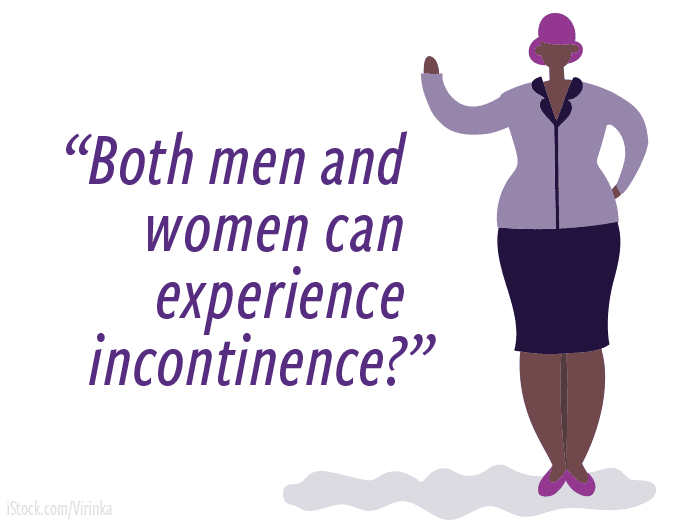I will admit that on occasion I watch those sappy movies on Hallmark Channel TV. If you also do, you may have noticed MANY commercials selling adult diapers or medications for urinary incontinence. The people in these commercials are attractive older women, and appear very happy that their adult diapers fit beautifully under their tight-fitting clothes. As a pelvic health physical therapist, these commercials drive me crazy since I know that urinary incontinence is treatable, it affects MEN and women, and for many, all it requires is some education, lifestyle changes and exercise.
The question should be: Why am I peeing in my pants and what can I do about it?
How does a normal bladder work?
Normal bladder function is a process that involves nerves, skeletal muscle and smooth muscle; skeletal muscle moves under voluntary control, while smooth muscle does not. Bladder control requires the brain, spinal cord, nerves, bladder muscles and pelvic floor muscles to all work together. The wall of the bladder contains the detrusor muscle (smooth muscle), the neck of the bladder contains the internal urethral sphincter (smooth muscle), and the pelvic floor (muscles in the groin area) contains the external urethral sphincter (skeletal muscle). Urine collects in the bladder, stretching the detrusor muscle, and the internal urethral sphincter contracts to hold the urine in the bladder. When the bladder gets full, nerves signal the brain to tell us that it’s time to use the bathroom. When we decide to pee, the external urethral sphincter loosens, followed by relaxation of the internal urethral sphincter and subsequent contraction of the detrusor muscle. (see picture) If there is an abnormality to any part of the mechanism—like a brain or spinal cord injury, nerve injury, or muscle weakness—bladder control may not occur.
Are there different types of urinary incontinence?
For neurologically healthy people, there are several types of incontinence: stress, urge, mixed, and functional. Stress incontinence is involuntary loss of urine with effort or physical exertion such as coughing, lifting, jumping or running. Little bit of urinary leakage when you sneeze? Stress incontinence! These activities increase pressure inside the abdomen and push against the bladder and pelvic floor. A weak pelvic floor will not be able to resist the force of the intra-abdominal pressure and urine may leak out of the bladder. Stress incontinence is often seen in women postpartum. After a baby is moved through those pelvic floor muscles, they may need a little rehab to make sure they are working correctly!

Urge incontinence is involuntary loss of urine because of a compelling desire to urinate that is difficult to control, resulting in urinary leakage. Urge incontinence is due to detrusor instability, a process in which the bladder contracts even with very small amounts of urine in the bladder. Urge incontinence is often caused by triggers, such as running water or unavailability of a bathroom. When you feel like you are going to pee in your pants as you try to unlock your door after a long day, that’s urge incontinence! Over-active bladder syndrome, which is frequent urinary urgency that often happens throughout the night, can also be a cause of urge incontinence. Are you sleeping poorly because you have to go to the bathroom three or four times a night? Urge incontinence!
Mixed incontinence is a combination of stress and urge. Functional incontinence is the inability for the individual to either perceive the need to urinate and/or to move quickly enough to get to the bathroom before loss of bladder control; it’s often seen in elderly individuals with cognitive impairment or mobility issues.
Am I at risk for incontinence?
Incontinence is common—more so in women than men—and increases with age. Obesity, pregnancy, high caffeine intake, certain medications and diseases, urinary tract infections, and surgeries to the pelvic area (prostate surgery, hysterectomy, etc.), are all additional risk factors. Many of my female patients struggle with urinary leakage after the birth of their children, and accept it as their new normal. It goes unresolved because they don’t think to discuss it with their primary care provider or obstetrician; for some now in their 60’s and 70’s, wearing pads or diapers is a daily necessity.

If you are a healthy individual—young or old, male or female—and you have to wear a pad so you don’t wet your pants, this is NOT normal. If you have had a baby and are still dripping pee after 6 weeks’ post-partum, it’s time to talk with your obstetrician and get your pelvic floor back in shape. If you are getting up more than twice a night to pee, or are unable to sit through a movie, travel in your car, or go to a store without worrying about where the bathroom is, there are many resources and professionals that can help. Your primary care provider will determine the causative factors behind your incontinence and help you determine if you need physical therapy, medications, or further testing.
Physical therapy for incontinence
Physical therapists will teach you the anatomy and physiology around micturition (urination). We evaluate your lifestyle behaviors, including drinking, eating, and bladder habits, and educate you on how they relate to your incontinence. We’ll also perform an assessment of your pelvic floor and general body strength, and educate you on strategies to relax the “urge” of urge incontinence. Through education and biofeedback training, your physical therapist will teach you pelvic floor exercises, and ways to strengthen your abdominals, back and hip muscles. We will work with you to improve your incontinence so you can enjoy activities like running, jumping, or lifting without worry. Let’s stop buying diapers and pads, stop being embarrassed about our leakage, and speak to someone that can help. The time and expense you put into rehabilitation and exercise is less than you will put into the cost of buying and using protective incontinence products for the rest of your life, and you may be surprised at how easy it is to improve your incontinence with education, lifestyle changes, and exercise!
If you need assistance for urinary incontinence, whether male or female, the Des Moines University Physical Therapy Clinic can help. Visit our website or call 515-271-1717 to schedule your appointment today.

